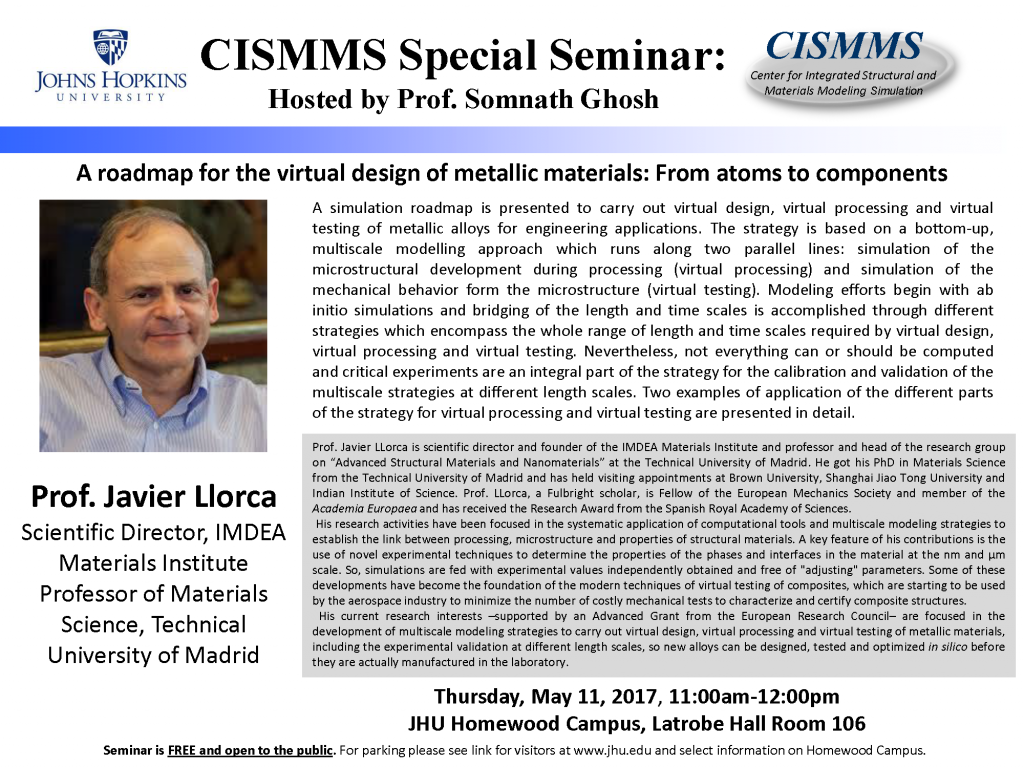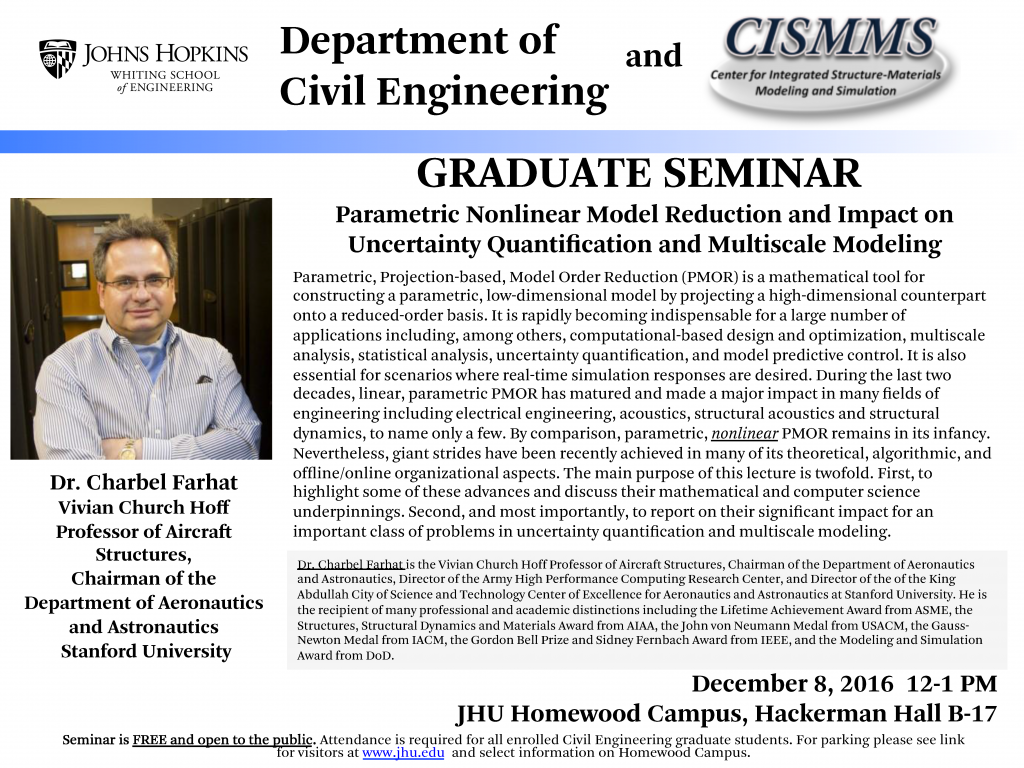Archives: Events
Title:
Magnetics + Mechanics + Nanoscale = Electromagnetics Future
Abstract:
Efficient control of small scale magnetism presents a significant problem for future miniature electromagnetic devices. In most macroscale electromagnetic systems we rely on a discovery made by Oersted 200 years ago where an electrical current through a wire creates a distributed magnetic field. While this concept works well at large scale, it suffers significant problems at volumes below 1 mm3. One approach to control nanoscale magnetic states is spin-transfer torque (STT). However, experimental measurements on STT memory devices indicates that 100 fJ is required to reorient a bit of memory with an energy barrier of about 0.5 aJ, i.e., at 0.0005 percent efficiency. Therefore, new nanoscale approaches are needed for future miniature electromagnetic devices.
Recently, researchers have explored strain-mediated multiferroic composites to resolve this problem. For this material class, a voltage-induced strain alters the magnetic anisotropy of the magneto-elastic elements. These strain-mediated multiferroics consists of a piezoelectric material coupled to magneto-elastic elements to transfer electrical energy to magnetic energy through a mechanical transduction. The coupling coefficient (energy transferred) in piezoelectric materials (e.g., lead zirconate titanate, PZT) is approximately 0.8 while the coupling coefficient in magneto-elastic materials (e.g., Tb-Dy-Fe, Terfenol-D) is of similar magnitude, 0.8. Thus, the amount of energy to overcome a 0.5 aJ bit barrier is potentially only 0.8 aJ, or an efficiency of about 60 percent, neglecting line losses.
This presentation reviews the motivation, history, and recent progress in nanoscale strain-mediated multiferroics. Research descriptions include analytical and experimental work on strain-mediated multiferroic thin films, single magnetic domain structures, and superparamagnetic particles. The results indicate efficiencies orders of magnitude superior to STT approaches and presents a new approach to control magnetism. Discussions of future research opportunities and novel applications are included.
About the speaker: Greg Carman received his Ph.D. degree from Virginia Polytechnic Institute and State University in 1991. He joined the Mechanical and Aerospace Engineering Department at the University of California, Los Angeles, in 1991. He is the director of a new National Science Foundation Engineering Research Center entitled Translational Applications of Nanoscale Multiferroic Materials (TANMS) and is engineering director of the Center for Advanced Surgical and Interventional Technology in the Department of Surgery at UCLA. He is an associate editor for the Journal of Intelligent Material Systems Structures and for Smart Materials and Structures. He received the Northrop Grumman Young Faculty Award in 1995 and three best paper awards from the American Society of Mechanical Engineers (ASME) in 1996, 2001, and 2007. He was elected Fellow of the ASME in 2003 and was awarded the ASME Adaptive Structures and Material Systems Prize honoring his contributions to smart materials and structures in 2004. In 2015 SPIE honored him with the Smart Structures and Materials (SSM) Lifetime Achievement Award. Presently his research interests focus on analytical modeling, fabrication, and testing of multiferroic (magneto-electric) materials and developing devices for medical applications.
Title:
Time-Reversal and Reciprocity Breaking in Electromechanical Metamaterials and Structural Lattices
Abstract:
Recent breakthroughs in condensed matter physics are opening new directions in band engineering and wave manipulation. Specifically, challenging the notions of reciprocity, time-reversal symmetry and sensitivity to defects in wave propagation may disrupt ways in which mechanical and acoustic metamaterials are designed and employed, and may enable totally new functionalities. Non-reciprocity and topologically protected wave propagation will have profound implications on how stimuli and information are transmitted within materials, or how energy can be guided and steered so that its effects may be controlled or mitigated.
The seminar will briefly introduce the state-of-the-art in this emerging field, and will present initial investigations on concepts exploiting electro-mechanical coupling and chiral and non-local interactions in mechanical lattices. Shunted piezo-electric patches are exploited to achieve time-modulated mechanical properties which lead to one-directional wave propagation in one-dimensional mechanical waveguides. A framework to realize helical edge states in two identical lattices with interlayer coupling is also presented. The methodology systematically leads to mechanical lattices that exhibit one-way, edge-bound, defect-immune, non-reciprocal wave motion. The presented concepts find potential application in vibration reduction, noise control or stress wave mitigation systems, and as part of surface acoustic wave devices capable of isolator, gyrator and circulator-like functions on compact acoustic platforms.
About the speaker: Massimo Ruzzene is a Professor in the Schools of Aerospace and Mechanical Engineering at Georgia Institute of Technology. He received a PhD in Mechanical Engineering from the Politecnico di Torino (Italy) in 1999. He is author of 2 books, 140 journal papers and about 180 conference papers. He has participated as a PI or co-PI in various research projects funded by the Air Force Office of Scientific Research (AFOSR), the Army Research Office (ARO), the Office of Naval Research (ONR), NASA, the US Army, US Navy, DARPA, the National Science Foundation (NSF), as well as companies such as Boeing, Eurocopter, Raytheon, Corning and TRW. Most of his current and past research work has focused on solid mechanics, structural dynamics and wave propagation with application to structural health monitoring, metamaterials, and vibration and noise control. M. Ruzzene is a Fellow of ASME, an Associate Fellow of AIAA, and a member of AHS, and ASA. He is the Program Director for the Dynamics, Control and System Diagnostics Program of CMMI at the National Science Foundation.
The Department of Civil Engineering
Announces the Thesis Defense of
Jiahao Cheng
Thesis Advisor, Professor Somnath Ghosh
“Crystal Plasticity FE Models for Predicting Deformation and Twinning
in Polycrystalline Magnesium Alloys”
Thursday, March 10, 2016
10:00am-12:00pm
Latrobe 106










